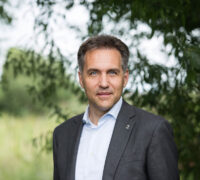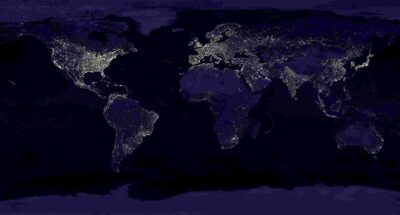
Energy efficiency equals smart strategy, so why the inertia?
Doing more with less energy is the fastest and cheapest way to cut emissions. Business leaders must do more to translate words into action....
Audio available
by Thomas Vellacott Published August 1, 2024 in Sustainability • 8 min read
In 1971, when the estimates calculated by the Global Footprint Network began, Earth Overshoot Day fell on 25 December. Twenty years ago, it was 2 September. This year, it is 1 August. If we ran Earth as a business, we would quickly go bankrupt.
After each Earth Overshoot Day, we live in ecological debt for the rest of the year, eating up our natural capital with no credible plan to ever pay this back. Every year we are quicker and quicker to use up these resources. To sustain our current lifestyles, using up more resources than we can afford, we would need the equivalent of 1.7 Earths.
In Switzerland, where I am from, we like to think of ourselves as thrifty. We like to plan for contingencies, and we have great national stockpiles in case of war – and yet if everyone lived like us, Earth Overshoot Day would fall on 27 May. We too are living far beyond our means.
How can we change course? How can we avoid the ultimate debt collection: an uninhabitable climate and a human-induced sixth mass extinction of species? And how can Switzerland, a tiny speck on our big planet, help shape the transition?
The stakes are high. The World Economic Forum, which since 2010 has ranked the most severe risks our economies face, now places biodiversity loss and ecosystem collapse as the third greatest long-term risk to the global economy, behind extreme weather events and critical changes to Earth systems. Natural resource shortages come in fourth. In other words, the top four risks to the global economy in the next ten years come from a degraded environment.
We are nothing without nature. Nature provides natural resources and its associated ecosystem services, including pollination, regulation of the water cycle, and air quality regulation. The forestry, agriculture, fisheries and aquaculture, food, beverages and tobacco, heat utilities, and construction have in common the fact that 100% of their direct gross value added is highly dependent on nature; 70% of the 124 most used crops in agriculture rely on insect pollination; 70% of all cancer drugs have natural origins; and 70% of the world’s freshwater withdrawal is used for agriculture. This is what is at stake if we do not start living more sustainably on the only Earth we have: we risk losing not only entire industries but also putting in jeopardy our well-being and our very existence.
Putting nature at risk puts the economy and businesses at risk. Those companies that address these challenges the soonest – before regulations kick in – will benefit the most from setting far-sighted strategies today, minimizing risks to their operations and offering solutions that allow us to thrive in a resource-constrained future. Not only do we need to halt nature loss, but we also need to reverse the trend by 2030. The world economy needs to find new ways to operate that halt harm and regenerate nature, ensuring they do their part towards the global Nature Positive Initiative goal.
Switzerland is a case in point. Although Switzerland is a small country, its footprint is global, and it has an outsized impact on global biodiversity. There is, first, our own internal consumption and production. A 2020 WWF study found that the land required for its annual imports of forest products and agricultural commodities was approximately 2 million hectares – half the area of Switzerland itself!
Second, Switzerland has one of the highest concentrations of multinational corporations headquartered in the country and hosts a large financial services and commodity trading industry. Through these companies’ in-house operations and supply chains, we have outsized impacts beyond our borders.
For small, open economies like Switzerland that are strongly involved in global trade, the importance of their upstream value chain is particularly relevant. The Environmental Atlas Switzerland examined eight selected Swiss industries and found that the environmental impacts in their supply chains are significantly greater than the direct environmental impacts of the industries themselves.
Furthermore, a substantial portion of the value creation within a supply chain occurs abroad. For instance, the chemical industry, machine engineering industry, and food retail industry generate ~44%, ~36%, and ~37% of their GDP outside Switzerland, respectively.
Measures to reduce the biodiversity impact of industries must therefore include their supply chains. What is more, it is important to identify where a company has an impact on nature: most ‘high-priority hotspots’ for biodiversity identified by WWF are located outside Switzerland and Europe. These are areas containing the highest numbers of species at risk, and therefore where companies can have the greatest impact, positive or negative.
Instead of lagging as it does, Switzerland could instead lead the way to sustainability through the network of multinational companies based here. Action by companies here has global ramifications, and these can be positive for nature.
The good news is that more companies are becoming aware of their impact on nature and are starting to act, whether through systematic measurements of their impacts on biodiversity, actively promoting regenerative agriculture practices among their suppliers, increasing their share of certified products, or engaging in landscape approaches. It is time for companies not only to understand the risks nature loss poses to their business, but also to quantify how their business impacts the environment, and how they can change this. What is needed is a transformation to operating within planetary boundaries, which requires changes to be made to operations and sometimes even business models. Understandably, given all the noise, even those with the best intentions sometimes find it hard to act. It can all seem overwhelming. Where to start?
The WWF Biodiversity Stewardship Framework proposes a pragmatic approach to support companies in their transformation planning. It provides detailed guidance along five key steps: Assess, Embed, Implement, Advocate, and Achieve. For each step, specific tools, standards, and guidance materials are made available to companies. The standards include science-based targets with a focus on target setting (SBTN) as well as recommendations for reporting and disclosure based on the principles of the Taskforce on Nature-related Financial Disclosures (TNFD).
Businesses providing appropriate response measures to their direct and indirect impacts can also use their influence to advocate for nature and to contribute financially to its restoration.
Financial schemes and mechanisms to invest in nature are booming. Regulations, disclosure standards, science-based methodologies, and tools to address nature risks and impacts are rapidly evolving too. Financial institutions and insurance companies increasingly recognize exposure to nature-related risks as a decision factor in their portfolios. Pressure is increasing on companies to address their nature-related impacts and dependencies.
While there is still much work to do, solutions do exist. Better yet, there are new untapped opportunities in the upcoming nature-positive markets. Companies that know what their exposure to nature risk is, who can quantify their impact, and set targets to help us push back the clock on Overshooting Earth will be those that thrive in the future. We cannot keep living on borrowed time.
For our part, WWF is hosting the WWF Business & Biodiversity Forum, which takes place on September 19, in Brussels and online. This event invites corporates to reflect on and discuss the key issues relating to nature and businesses, with sessions on key regulations and methodologies, and numerous testimonies from frontrunner companies.

CEO of the World Wildlife Fund (WWF) Switzerland
Thomas Vellacott is the CEO of the World Wildlife Fund (WWF) Switzerland. He joined the charity in 2001, where he spent eight years heading up the program division before becoming CEO in 2012. He previously worked in private banking for Citibank and as a consultant at McKinsey & Co. He studied Arabic and international relations at Durham, Cairo, and Cambridge universities.

October 28, 2025 • by Clara Camarasa in Sustainability
Doing more with less energy is the fastest and cheapest way to cut emissions. Business leaders must do more to translate words into action....
 Audio available
Audio available
October 24, 2025 • by Luca Condosta, Alexander Fleischmann in Sustainability
Companies gain performance advantages through LGBTQ+ inclusion, yet nearly nine in 10 Swiss firms lag. Here’s how leaders can close the gap....

October 22, 2025 • by Amit Gulwadi, Amy Lau in Sustainability
Many C-suite executives are torn between the need for a green transition and maintaining a competitive advantage. Here are five ways to find a clear path ahead....
 Audio available
Audio available
October 21, 2025 • by Julia Binder, Esther Salvi in Sustainability
Nadine Sterley is reshaping how the world thinks about industrial machinery, pushing a 140-year old engineering giant to turn every valve, pipe, and production line into a force for climate action....
Explore first person business intelligence from top minds curated for a global executive audience